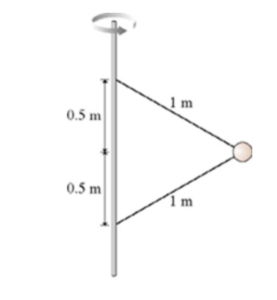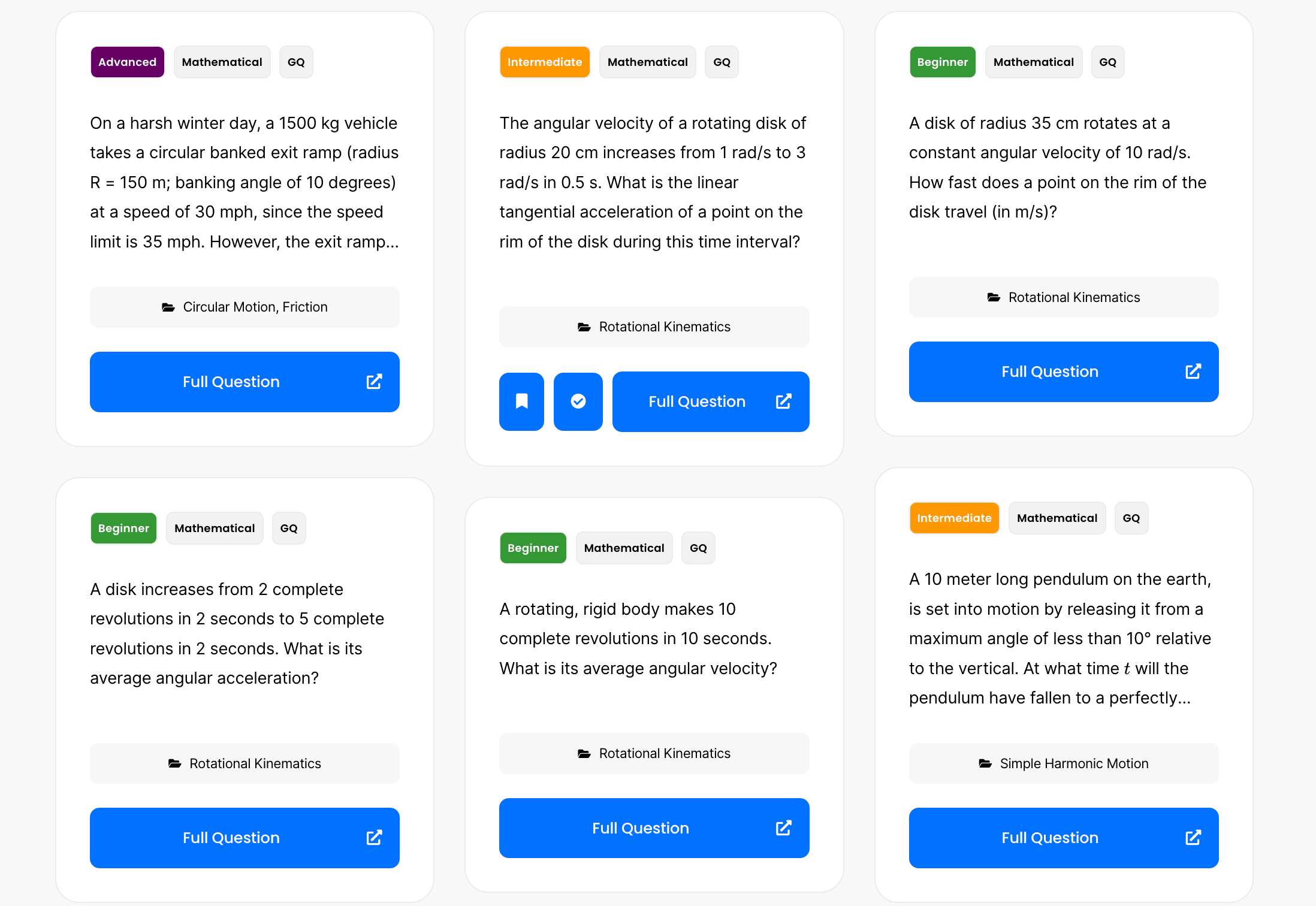| Step | Derivation/Formula | Reasoning |
|---|---|---|
| A1 | T – Mg = \frac{Mv^2}{L} | This is the force equilibrium equation at the bottom point. T is the tension in the string, M is the mass of the ball, g is the acceleration due to gravity, v is the velocity of the ball, and L is the length of the string. |
| A2 | T = 3Mg | The tension at the bottom is given to be three times the weight of the ball. |
| A3 | 3Mg – Mg = \frac{Mv^2}{L} | Substituting the tension value into the equilibrium equation. |
| A4 | v = \sqrt{2gL} | Simplifying the equation for v , observe M cancels out. This is velocity at any given point around the circle. |
| A5 | F_{\text{centripetal}} = \frac{Mv^2}{L} | At the top, we can use the velocity calculated in the previous step to find the centripetal force required to keep the ball moving in the circle. |
| A6 | 2mg | Substitute in the equation for velocity (from step A4) so that the final equation is in terms of M \, g \, L |
| B1 | v_{\text{top}} = \sqrt{v^2 – 4gL} | Using conservation of energy. KE_{\text{bottom}} + PE_{\text{bottom}} = KE_{\text{top}} + PE_{\text{top}} . The velocity at the top is found by noting the potential energy difference between top and bottom. Simplify by substituting v from A4. |
| B2 | v_{\text{top}} = \sqrt{2gL – 4gL} | = \sqrt{-2gL} \rightarrow which is zero since 2gL > 4gL |
| C1 | t = \sqrt{\frac{4L}{g}} | Ball falls freely under gravity and has no initial vertical velocity, so \delta y = \frac{1}{2}gt^2 ; solving for t gives the time to fall a distance L . Note that the displacement from the top to the bottom is twice the radius of the circle or 2L . |
| D1 | \Delta x = v_0t | The horiztontal distance traveled by any projectile is the product of the horiztonal speed and the time in air. |
| D2 | \sqrt{2gL} \times \sqrt{\frac{4L}{g}} | Substitute in velocity from Step A4 and time from step C1 |
| D3 | \sqrt{8}L | Simplify |
(a) The net force on the ball at the top is 2Mg , downward.
(b) The velocity of the ball at the top is v = \sqrt{2gL} .
(c) The time it takes to reach the ground is \sqrt{\frac{4L}{g}} .
(d) The horizontal distance traveled is \sqrt{8}L
Phy can also check your working. Just snap a picture!
An airplane with a speed of 97.5 m/s is climbing upward at an angle of 50.0° with respect to the horizontal. When the plane’s altitude is 732 m, the pilot releases a package.
A 2.2 kg ball on the end of a 0.35 m long string is moving in a vertical circle. At the bottom of the circle, its speed is 5.3 m/s. Find the tension in the string.
A 2.2 \times 10^{21} \, \text{kg} moon orbits a distant planet in a circular orbit of radius 1.5 \times 10^8 \, \text{m}. It experiences a 1.1 \times 10^{19} \, \text{N} gravitational pull from the planet. What is the moon’s orbital period in earth days?
Two wires are tied to the 500 g sphere shown below. The sphere revolves in a horizontal circle at a constant speed of 7.2 m/s. What is the tension in the upper wire? What is the tension in the lower wire?

You kick a soccer ball with an initial velocity directed 53° above the horizontal. The ball lands on a roof 7.2 m high. The wall of the building is 25 m away, and it takes the ball 2.1 seconds to pass directly over the wall.
(a) 2Mg , downward.
(b) v = \sqrt{2gL} .
(c) \sqrt{\frac{4L}{g}} .
(d) \sqrt{8}L
By continuing you (1) agree to our Terms of Sale and Terms of Use and (2) consent to sharing your IP and browser information used by this site’s security protocols as outlined in our Privacy Policy.
| Kinematics | Forces |
|---|---|
| \Delta x = v_i t + \frac{1}{2} at^2 | F = ma |
| v = v_i + at | F_g = \frac{G m_1m_2}{r^2} |
| a = \frac{\Delta v}{\Delta t} | f = \mu N |
| R = \frac{v_i^2 \sin(2\theta)}{g} |
| Circular Motion | Energy |
|---|---|
| F_c = \frac{mv^2}{r} | KE = \frac{1}{2} mv^2 |
| a_c = \frac{v^2}{r} | PE = mgh |
| KE_i + PE_i = KE_f + PE_f |
| Momentum | Torque and Rotations |
|---|---|
| p = m v | \tau = r \cdot F \cdot \sin(\theta) |
| J = \Delta p | I = \sum mr^2 |
| p_i = p_f | L = I \cdot \omega |
| Simple Harmonic Motion |
|---|
| F = -k x |
| T = 2\pi \sqrt{\frac{l}{g}} |
| T = 2\pi \sqrt{\frac{m}{k}} |
| Constant | Description |
|---|---|
| g | Acceleration due to gravity, typically 9.8 , \text{m/s}^2 on Earth’s surface |
| G | Universal Gravitational Constant, 6.674 \times 10^{-11} , \text{N} \cdot \text{m}^2/\text{kg}^2 |
| \mu_k and \mu_s | Coefficients of kinetic (\mu_k) and static (\mu_s) friction, dimensionless. Static friction (\mu_s) is usually greater than kinetic friction (\mu_k) as it resists the start of motion. |
| k | Spring constant, in \text{N/m} |
| M_E = 5.972 \times 10^{24} , \text{kg} | Mass of the Earth |
| M_M = 7.348 \times 10^{22} , \text{kg} | Mass of the Moon |
| M_M = 1.989 \times 10^{30} , \text{kg} | Mass of the Sun |
| Variable | SI Unit |
|---|---|
| s (Displacement) | \text{meters (m)} |
| v (Velocity) | \text{meters per second (m/s)} |
| a (Acceleration) | \text{meters per second squared (m/s}^2\text{)} |
| t (Time) | \text{seconds (s)} |
| m (Mass) | \text{kilograms (kg)} |
| Variable | Derived SI Unit |
|---|---|
| F (Force) | \text{newtons (N)} |
| E, PE, KE (Energy, Potential Energy, Kinetic Energy) | \text{joules (J)} |
| P (Power) | \text{watts (W)} |
| p (Momentum) | \text{kilogram meters per second (kgm/s)} |
| \omega (Angular Velocity) | \text{radians per second (rad/s)} |
| \tau (Torque) | \text{newton meters (Nm)} |
| I (Moment of Inertia) | \text{kilogram meter squared (kgm}^2\text{)} |
| f (Frequency) | \text{hertz (Hz)} |
General Metric Conversion Chart
Example of using unit analysis: Convert 5 kilometers to millimeters.
Start with the given measurement: \text{5 km}
Use the conversion factors for kilometers to meters and meters to millimeters: \text{5 km} \times \frac{10^3 \, \text{m}}{1 \, \text{km}} \times \frac{10^3 \, \text{mm}}{1 \, \text{m}}
Perform the multiplication: \text{5 km} \times \frac{10^3 \, \text{m}}{1 \, \text{km}} \times \frac{10^3 \, \text{mm}}{1 \, \text{m}} = 5 \times 10^3 \times 10^3 \, \text{mm}
Simplify to get the final answer: \boxed{5 \times 10^6 \, \text{mm}}
Prefix | Symbol | Power of Ten | Equivalent |
|---|---|---|---|
Pico- | p | 10^{-12} | 0.000000000001 |
Nano- | n | 10^{-9} | 0.000000001 |
Micro- | µ | 10^{-6} | 0.000001 |
Milli- | m | 10^{-3} | 0.001 |
Centi- | c | 10^{-2} | 0.01 |
Deci- | d | 10^{-1} | 0.1 |
(Base unit) | – | 10^{0} | 1 |
Deca- or Deka- | da | 10^{1} | 10 |
Hecto- | h | 10^{2} | 100 |
Kilo- | k | 10^{3} | 1,000 |
Mega- | M | 10^{6} | 1,000,000 |
Giga- | G | 10^{9} | 1,000,000,000 |
Tera- | T | 10^{12} | 1,000,000,000,000 |
The most advanced version of Phy. Currently 50% off, for early supporters.
per month
Billed Monthly. Cancel Anytime.
Trial –> Phy Pro
A quick explanation
UBQ credits are specifically used to grade your FRQs and GQs.
You can still view questions and see answers without credits.
Submitting an answer counts as 1 attempt.
Seeing answer or explanation counts as a failed attempt.
Lastly, check your average score, across every attempt, in the top left.
MCQs are 1 point each. GQs are 1 point. FRQs will state points for each part.
Phy can give partial credit for GQs & FRQs.
Phy sees everything.
It customizes responses, explanations, and feedback based on what you struggle with. Try your best on every question!
Understand you mistakes quicker.

For GQs and FRQs, Phy provides brief feedback as to how you can improve your answer.
Aim to increase your understadning and average score with every attempt!
10 Free Credits To Get You Started
*Phy Pro members get unlimited credits

By continuing you agree to nerd-notes.com Terms of Service, Privacy Policy, and our usage of user data.